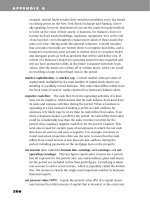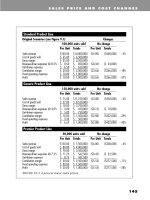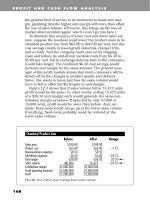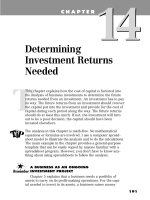The Fast Forward MBA in Finance SECOND EDITION potx
Bạn đang xem bản rút gọn của tài liệu. Xem và tải ngay bản đầy đủ của tài liệu tại đây (1.39 MB, 337 trang )
TEAMFLY
Team-Fly
®
The
Fast Forward
MBA in Finance
The
Fast Forward
MBA in Finance
SECOND EDITION
The Fast Forward MBA Pocket Reference, Second Edition
(0-471-22282-8)
by Paul A. Argenti
The Fast Forward MBA in Selling
(0-471-34854-6)
by Joy J.D. Baldridge
The Fast Forward MBA in Financial Planning
(0-471-23829-5)
by Ed McCarthy
The Fast Forward MBA in Negotiating and Dealmaking
(0-471-25698-6)
by Roy J. Lewicki and Alexander Hiam
The Fast Forward MBA in Project Management
(0-471-32546-5)
by Eric Verzuh
The Fast Forward MBA in Business Planning for Growth
(0-471-34548-2)
by Philip Walcoff
The Fast Forward MBA in Business Communication
(0-471-32731-X)
by Lauren Vicker and Ron Hein
The Fast Forward MBA in Investing
(0-471-24661-1)
by John Waggoner
The Fast Forward MBA in Hiring
(0-471-24212-8)
by Max Messmer
The Fast Forward MBA in Technology Management
(0-471-23980-1)
by Daniel J. Petrozzo
The Fast Forward MBA in Marketing
(0-471-16616-2)
by Dallas Murphy
The Fast Forward MBA in Business
(0-471-14660-9)
by Virginia O’Brien
THE FAST FORWARD MBA SERIES
The Fast Forward MBA Series provides time-pressed business profes-
sionals and students with concise, one-stop information to help them
solve business problems and make smart, informed business decisions.
All of the volumes, written by industry leaders, contain “tough ideas
made easy.” The published books in this series are:
John Wiley & Sons, Inc.
The
Fast Forward
MBA in Finance
JOHN A. TRACY
The
Fast Forward
MBA in Finance
SECOND EDITION
Copyright © 1996, 2002 by John A. Tracy. All rights reserved.
Published by John Wiley & Sons, Inc., New York.
Published simultaneously in Canada.
No part of this publication may be reproduced, stored in a retrieval system
or transmitted in any form or by any means, electronic, mechanical, photo-
copying, recording, scanning or otherwise, except as permitted under Sec-
tions 107 or 108 of the 1976 United States Copyright Act, without either the
prior written permission of the Publisher, or authorization through payment
of the appropriate per-copy fee to the Copyright Clearance Center, 222 Rose-
wood Drive, Danvers, MA 01923, (978) 750-8400, fax (978) 750-4744.
Requests to the Publisher for permission should be addressed to the Permis-
sions Department, John Wiley & Sons, Inc., 605 Third Avenue, New York,
NY 10158-0012, (212) 850-6011, fax (212) 850-6008, E-Mail:
This publication is designed to provide accurate and authoritative informa-
tion in regard to the subject matter covered. It is sold with the understand-
ing that the publisher is not engaged in rendering professional services. If
professional advice or other expert assistance is required, the services of a
competent professional person should be sought.
Wiley also publishes its books in a variety of electronic formats. Some con-
tent that appears in print may not be available in electronic books.
ISBN: 0-471-20285-1
Printed in the United States of America.
10 9 8 7 6 5 4 3 2 1
for
Richard and Robert, my dog track buddies,
who have helped me more than they know.
CONTENTS
PREFACE
xiii
PART 1
FINANCIAL REPORTING OUTSIDE
AND INSIDE A BUSINESS
CHAPTER 1—GETTING DOWN TO BUSINESS
3
Accounting Inside and Out 4
Internal Functions of Accounting 6
External Functions of Accounting 6
A Word about Accounting Methods 8
End Point 9
CHAPTER 2—INTRODUCING FINANCIAL
STATEMENTS
11
Three Financial Imperatives, Three Financial
Statements 11
Accrual-Basis Accounting 13
The Income Statement 16
The Balance Sheet 18
The Statement of Cash Flows 21
End Point 24
CHAPTER 3—REPORTING PROFIT
TO MANAGERS
27
Using the External Income Statement
for Decision-Making Analysis 27
Management Profit Report 31
Contribution Margin Analysis 35
End Point 36
CHAPTER 4—INTERPRETING FINANCIAL
STATEMENTS
39
A Few Observations and Cautions 39
Premises and Principles of Financial Statements 41
Limits of Discussion 46
Profit Ratios 47
Book Value Per Share 49
Earnings Per Share 51
Market Value Ratios 53
Debt-Paying-Ability Ratios 55
Asset Turnover Ratios 58
End Point 59
PART 2
ASSETS AND SOURCES OF CAPITAL
CHAPTER 5—BUILDING A BALANCE SHEET
63
Sizing Up Total Assets 63
Assets and Sources of Capital for Assets 66
Connecting Sales Revenue and Expenses
with Operating Assets and Liabilities 69
Balance Sheet Tethered with Income Statement 75
End Point 76
CHAPTER 6—BUSINESS CAPITAL SOURCES
79
Business Example for This Chapter 80
Capital Structure of Business 81
Return on Investment 86
Pivotal Role of Income Tax 89
Return on Equity (ROE) 91
CONTENTS
viii
Financial Leverage 92
End Point 95
CHAPTER 7—CAPITAL NEEDS OF GROWTH
97
Profit Growth Plan 98
Planning Assets and Capital Growth 99
End Point 105
PART 3
PROFIT AND CASH FLOW ANALYSIS
CHAPTER 8—BREAKING EVEN
AND MAKING PROFIT
109
Adding Information in the Management Profit Report 109
Fixed Operating Expenses 112
Depreciation: A Special Kind of Fixed Cost 113
Interest Expense 116
Pathways to Profit 116
End Point 122
CHAPTER 9—SALES VOLUME CHANGES
125
Three Ways of Making a $1 Million Profit 126
Selling More Units 129
Sales Volume Slippage 133
Fixed Costs and Sales Volume Changes 134
End Point 136
CHAPTER 10—SALES PRICE
AND COST CHANGES
139
Sales Price Changes 139
When Sales Prices Head South 144
Changes in Product Cost and Operating Expenses 146
End Point 148
CHAPTER 11—PRICE/VOLUME TRADE-OFFS
149
Shaving Sales Prices to Boost Sales Volume 150
Volume Needed to Offset Sales Price Cut 154
Thinking in Reverse: Giving Up Sales Volume
for Higher Sales Prices 157
End Point 159
ix
CONTENTS
CHAPTER 12—COST/VOLUME TRADE-OFFS
AND SURVIVAL ANALYSIS
161
Product Cost Increases: Which Kind? 161
Variable Cost Increases and Sales Volume 163
Better Product and Service Permitting Higher
Sales Price 165
Lower Costs: The Good and Bad 166
Subtle and Not-So-Subtle Changes in Fixed Costs 169
Survival Analysis 170
End Point 177
CHAPTER 13—PROFIT GUSHES: CASH FLOW
TRICKLES?
179
Lessons from Chapter 2 179
Cash Flow from Boosting Sales Volumes 180
Cash Flows across Different Product Lines 185
Cash Flow from Bumping Up Sales Prices 185
End Point 188
PART 4
CAPITAL INVESTMENT ANALYSIS
CHAPTER 14—DETERMINING INVESTMENT
RETURNS NEEDED
191
A Business as an Ongoing Investment Project 191
Cost of Capital 192
Short-Term and Long-Term Asset Investments 195
The Whole Business versus Singular Capital
Investments 196
Capital Investment Example 197
Flexibility of a Spreadsheet Model 206
Leasing versus Buying Long-Term Assets 206
A Word on Capital Budgeting 210
End Point 210
Chapter Appendix 211
CHAPTER 15—DISCOUNTING INVESTMENT
RETURNS EXPECTED
213
Time Value of Money and Cost of Capital 214
Back to the Future: Discounting Investment Returns 215
CONTENTS
x
TEAMFLY
Team-Fly
®
Spreadsheets versus Equations 217
Discounted Cash Flow (DCF) 218
Net Present Value and Internal Rate of Return (IRR) 222
After-Tax Cost-of-Capital Rate 224
Regarding Cost-of-Capital Factors 226
End Point 227
PART 5
END TOPICS
CHAPTER 16—SERVICE BUSINESSES
231
Financial Statement Differences of Service
Businesses 232
Management Profit Report for a Service
Business 234
Sales Price and Volume Changes 237
What about Fixed Costs? 239
Trade-off Decisions 239
End Point 241
CHAPTER 17—MANAGEMENT CONTROL
243
Follow-through on Decisions 244
Management Control Information 244
Internal Accounting Controls 247
Independent Audits and Internal Auditing 249
Fraud 250
Management Control Reporting Guidelines 252
Sales Mix Analysis and Allocation of Fixed Costs 262
Budgeting Overview 270
End Point 273
CHAPTER 18—MANUFACTURING
ACCOUNTING
275
Product Makers versus Product Resellers 275
Manufacturing Business Example 276
Misclassification of Manufacturing Costs 280
Idle Production Capacity 283
Manufacturing Inefficiencies 285
xi
CONTENTS
Excessive Production 287
End Point 289
APPENDIX A GLOSSARY FOR MANAGERS
291
APPENDIX B TOPICAL GUIDE TO FIGURES
313
INDEX
315
CONTENTS
xii
xiii
PREFACE
T
This book is for business managers, as well as for bankers,
consultants, lawyers, and other professionals who need a
solid and practical understanding of how business makes
profit, cash flow from profit, the assets and capital needed to
support profit-making operations, and the cost of capital.
Business managers and professionals don’t have time to
wade through a 600-page tome; they need a practical guide
that gets to the point directly with clear and convincing
examples.
In broad terms this book explains the tools of the trade for
analyzing business financial information. Financial state-
ments are one primary source of such information. There-
fore financial statements are the best framework to explain
and demonstrate how managers analyze financial informa-
tion for making decisions and keeping control. Surprisingly,
most books of this ilk do not use the financial statements
framework. My book offers many advantages in this re-
spect.
This book explains and clearly demonstrates the indispen-
sable analysis techniques that street-smart business managers
use to:
•
Make profit.
•
Control the capital invested in assets used in making profit
and in deciding on the sources of capital for asset invest-
ments.
•
Generate cash flow from profit.
The threefold orientation of this book fits hand in glove
with the three basic financial statements of every business:
the profit report (income statement), the financial condition
report (balance sheet), and the cash flow report (statement of
cash flows). These three “financials” are the center of gravity
for all businesses.
This book puts heavy emphasis on cash flow. Business
managers should never ignore the cash flow consequences of
their decisions. Higher profit may mean lower cash flow;
managers must clearly understand why, as well as the cash
flow timing from their profit.
The book begins with a four-chapter introduction to finan-
cial statements. Externally reported financial statements are
prepared according to generally accepted accounting princi-
ples (GAAP). GAAP provide the bedrock rules for measuring
profit. Business managers obviously need to know how much
profit the business is earning.
But, to carry out their decision-making and control func-
tions, managers need more information than is reported in
the external profit report of the business. GAAP are the point
of departure for preparing the more informative financial
statements and other internal accounting reports needed by
business managers.
The “failing” of GAAP is not that these accounting rules are
wrong for measuring profit, nor are they wrong for presenting
the financial condition of a business—not at all. It’s just that
GAAP do not deal with presenting financial information to
managers. In fact, much of this management information is
very confidential and would never be included in an external
financial report open to public view.
Let me strongly suggest that you personalize every example
in the book. Take the example as your own business; imagine
that you are the owner or the top-level manager of the busi-
ness, and that you will reap the gains of every decision or suf-
fer the consequences, as the case may be.
If you would like a copy of my Excel workbook file of all
the figures in the book contact me at my e-mail address:
PREFACE
xiv
As usual, the editors at John Wiley were superb. Likewise,
the eagle-eyed copy editors at North Market Street Graphics
polished my prose to a much smoother finish. I would like to
mention that John Wiley & Sons has been my publisher for
more than 25 years, and I’m very proud of our long relation-
ship.
John A. Tracy
Boulder, Colorado
March, 2002
xv
PREFACE
Financial
Reporting
Outside
and Inside
a Business
1
1
PART
1
CHAPTER
Getting Down
to Business
E
1
Every business has three primary financial tasks that deter-
mine the success or failure of the enterprise and by which its
managers are judged:
•
Making profit—avoiding loss and achieving profit goals by
making sales or earning other income and by controlling
expenses
•
Cash flow—generating cash from profit and securing cash
from other sources and putting the cash inflow to good use
•
Financial health—deciding on the financial structure for
the entity and controlling its financial condition and sol-
vency
To continue in existence for any period of time, a
business has to make profit, generate cash flow,
and stay solvent.
Accomplishing these financial objectives depends on doing
all the other management functions well. Business managers
earn their keep by developing new products and services,
expanding markets, improving productivity, anticipating
changes, adapting to new technology, clarifying the business
model, thinking out clear strategies, hiring and motivating
people, making tough choices, solving problems, and arbitrat-
ing conflicts of interests between different constituencies (e.g.,
3
customers who want lower prices versus employees who want
higher wages). Managers should act ethically, comply with a
myriad of laws, be responsible members of society, and not
harm our natural environment—all the while making profit,
generating cash flow, and avoiding insolvency.
ACCOUNTING INSIDE AND OUT
Ask people to describe accounting and the most
common answer you’ll get is that accounting involves a lot of
record keeping and bookkeeping. Which is true. The account-
ing system of a business is designed to capture and record all
its transactions, operations, activities, and other develop-
ments that have financial consequences. An accounting sys-
tem generates many documents, forms, and reports. Even a
small business has hundreds of accounts, which are needed to
keep track of its sales and expenses, its assets and liabilities,
and of course its cash flows. Accounting systems today are
computer-based. The accounts of a business are kept on the
hard disks of computers, which should be backed up fre-
quently, of course.
The primary purpose of an accounting system is to accu-
mulate a complete, accurate, and up-to-date base of data and
information needed to perform essential functions for a busi-
ness. Figure 1.1 presents a broad overview of the internal and
external functions of business accounting. Note the Janus, or
two-faced, nature of an accounting system that looks in two
different directions—internal and external, or inside and out-
side the business.
In addition to facilitating day-to-day operating activities,
the accounting department of a business has the responsibility
of preparing two different kinds of internal reports—very
detailed reports for management control and much more con-
densed reports for decision making. Likewise, the accounting
department prepares two different kinds of external reports—
financial reports for owners and lenders and tax returns for
tax authorities. Accountants have a relatively free hand in
designing control and decision-making reports for managers.
In sharp contrast, external reporting is compliance-driven.
External financial reports must comply with authoritative
standards and established accounting rules. And, as I’m sure
you know, tax returns must comply with tax laws.
FINANCIAL REPORTING
4
TEAMFLY
Team-Fly
®
5
GETTING DOWN TO BUSINESS
FIGURE 1.1 Primary functions of accounting.
Accounting System
Facilitating operations
Main examples include:
•
Payroll
•
Purchasing
•
Billing and cash collections
•
Cash disbursements
•
Property records
Management control
reports
Main features:
•
Comparison of actual per-
formance and results
against plans, goals, and
timetables
•
Very detail oriented
•
Problems and out-of-control
areas highlighted
Management decision-
making reports
Main features:
•
Based on profit and cash
flow models
•
Designed for decision-
making analysis by man-
agers
•
Global focus on primary
factors that drive profit,
cash flow, and financial
condition
External financial reports
Main features:
•
Three primary financial state-
ments, as well as footnotes
and other disclosures
•
Prepared according to gener-
ally accepted accounting prin-
ciples (GAAP)
•
May be audited by CPA
•
Financial reporting by publicly
owned corporations also gov-
erned by federal securities
laws
Tax returns
Main types are:
•
Federal and state in-
come taxes
•
Property taxes
•
Sales taxes
•
Payroll taxes
INTERNAL FUNCTIONS OF ACCOUNTING
In addition to the day-to-day operational demands
(preparing payroll checks, paying bills on time, sending out
invoices to customers, etc.), Figure 1.1 reveals two other
internal functions of accounting: the preparation of manage-
ment control reports and reports for management decision
making. Management control demands attention to a very
large number of details; quite literally, thousands of things
can go wrong. Management decision making, in contrast,
focuses attention on relatively few key factors. Decision mak-
ing looks at the forest, not the trees. For decision-making
purposes, managers need accounting reports that are con-
densed and global in nature—that present the big picture.
These reports should resonate with the business model and
should be structured according to the profit and cash flow
models of the business.
In passing, I should mention that accounting information
seldom comprises the whole set of information needed for
decision making and control. Managers use many, many
other sources of information—competitors’ sales prices,
delivery problems with suppliers, employee morale, and so
on. Nonaccounting data comes from a wide diversity of
sources, including shopping the competition, sales force
reports, market research studies, personnel department
records, and so on. For example, customer files are very
important, and they usually include both accounting data
(past sales history) and nonaccounting data (sales reps
assigned to each customer).
EXTERNAL FUNCTIONS OF ACCOUNTING
Accountants have two primary external reporting
responsibilities: the preparation of tax returns and external
financial reports (see Figure 1.1 again). Exceedingly complex
and constantly changing laws, rules, and forms govern state
and federal income taxes, payroll taxes, property taxes, and
sales taxes. Accountants have their hands full just keeping up
with tax regulations and forms. Accountants also have to stay
abreast of changing accounting standards to prepare external
financial reports.
FINANCIAL REPORTING
6
External Financial Reports
In the next chapter I present an overview of external financial
reports. Please bear in mind that this book does not examine
in any great detail the external financial reports of business.*
This book is mainly concerned with internal reports to man-
agers and how managers analyze the information in these
reports for making decisions and for controlling the financial
performance of the business. Only a few brief comments
about external financial reporting of particular importance to
managers are mentioned here.
The financial statements of a business that are the core of
the external financial reports sent to its shareowners and
lenders must conform with generally accepted accounting
principles (GAAP). These are the authoritative guidelines,
rules, and standards that govern external financial reporting
to the outside investors and creditors of a business. The main
purpose of having financial statements audited by an inde-
pendent CPA firm is to test whether the statements have been
prepared according to GAAP. If there are material departures
from these ground rules of financial statement accounting and
disclosure, the CPA auditor says so in the audit opinion on the
financial statements.
External financial reports include footnotes that are an
integral addendum to the financial statements. Footnotes are
needed because the external financial report is directed to
outside investors and creditors of the business who are not
directly involved in the day-to-day affairs of the business.
Managers should already know most of the information dis-
closed in footnotes. If managers prefer to have certain foot-
notes included in their internal accounting reports, the
footnotes should be included—probably in much more detail
and covering more sensitive matters than footnotes presented
in external financial reports.
An external financial report includes three primary finan-
cial statements: One summarizes the profit-making activities
of the business for the period; one summarizes the cash
inflows and outflows for the same period; and one summa-
rizes the assets of the business at the end of the period that
are balanced by the claims against, and sources of, the assets.
7
GETTING DOWN TO BUSINESS
*Without too much modesty, I can recommend my book, How to Read a
Financial Report, 5th ed. (New York: John Wiley & Sons, 1999).
The three primary financial statements do not come with
built-in analysis. Rather, the financial statements provide an
organized source of information. It’s up to the users to extract
the vital signals and messages from the statements. As I
explain later, managers need much more information than are
reported in the external financial statements.
For example, suppose you’re about ready to lower sales
prices 10 percent because you think sales volume will
increase more than enough to make this a smart move. You’d
better know which profit and cash flow analysis tools to use to
test the impact of this decision on your business. The external
profit report does not provide the information you need.
Rather, you need the type of internal profit report explained in
Chapter 3 to analyze just how much sales volume would have
to increase in order to increase profit. You might be surprised
by how much sales volume would have to increase. If you
think sales volume would have to increase by only 10 percent,
you are dead wrong!
A WORD ABOUT ACCOUNTING METHODS
GAAP have been developed to standardize accounting meth-
ods for measuring net income (bottom-line profit), for present-
ing financial condition and cash flow information, and to
provide financial disclosure standards for reporting to exter-
nal investors and lenders to business. Over the years GAAP
have come a long way, but have not yet resulted in complete
uniformity and consistency from one business to the next, or
even among companies in the same industry. Businesses can
choose from among different but equally acceptable account-
ing methods, which can cause a material difference in the
profit (net income) reported for the year and in the values of
certain assets, liabilities, and owners’ equity accounts
reported in the financial statements of a business.
Profit depends on how it’s measured—in particular, on
which accounting methods have been selected and how the
methods are applied in practice. I’m reminded of the old base-
ball joke here: There’s an argument between the batter and the
catcher about whether the pitch was a ball or a strike. Back
and forth the two go, until finally the umpire settles it by saying
“It ain’t nothing until I call it.” Likewise, someone has to decide
how to “call” profit for the period; profit depends on how the
FINANCIAL REPORTING
8









